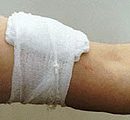Treatment of apoplexy of the ovary depends on the form of the disease. In case of massive blood loss, the urgent operation is shown. With insignificant intraperous blood loss without signs of increments of bleeding, conservative therapy is carried out.
Content
Principles of conservative treatment of apoplections of ovary
Treatment of patients with apoplexy of the ovary depends on the form of the disease and gravity of intra-abdominal bleeding. With pain and insignificant intra-abdominal blood loss (less than 150 ml) without signs of increasing bleeding, conservative therapy can be carried out. She turns out:
- rest
- ice on the bottom of the abdomen (contributes to the vessels of the vessels)
- Hemostatic preparations (ethanzilate)
- Antispasmodic agents (papaverin, but-shpa)
- Vitamins (Tiamine, Pyridoxin, Cyanocobalamin)
- Physiotherapeutic procedures (electrophoresis with calcium chloride, microwave therapy)
Surgical treatment of apoplexy
Conservative therapy is carried out in hospital under round-the-clock observation. With a re-attack of pain, deterioration of the overall state, instability of hemodynamics, increasing the amount of blood in the abdominal cavity clinically and with ultrasound scanning, indications appear for surgical intervention (laparoscopy, laparotomy).
Indications for laparoscopy:
- More than 150 ml of blood in the abdominal cavity, confirmed by physical research and ultrasound, with stable hemodynamic indicators and a patient's satisfactory condition
- The ineffectiveness of conservative therapy for 1-3 days, signs of continuing intra-abdominal bleeding, confirmed ultrasound
- Differential diagnosis of acute gynecological and acute surgical pathology
Indications for laparotomy:
- Signs of intra-abdominal bleeding, leading to hemodynamic disorders with severe patient (hemorrhagic shock)
- The impossibility of laparoscopy (due to the adhesive process, enhancing bleeding from damaged ovary vessels)
Prevention of apoplections of ovarian
 In patients with painful form of apoplexy of the ovarian violation of the central nervous system, hormonal profile and blood circulation in the ovary are reversible, in connection with which specific preventive measures are not required. In patients who suffered a hemorrhagic form of the apoplexy of the ovary, dysfunction of the highest divisions of the central nervous system, changes in the hormonal status and violation of ovarian blood flow are usually persistent. Such a patient shows comprehensive drug therapy, tearing vicious pathogenetic circle. For 3 months, therapy is carried out corrective activities of the brain structures - prescribe nootropics to improve metabolic processes in the central nervous system, preparations that improve cerebral perfusion (Cavinton, Tanakan, Vinpocetin), tranquilizers, with intracranial hypertension - diuretic drugs. To suppress ovulation and correction of a hormone profile for 3-6 months, combined estrogen-gestagenic monophazic low- and microstrosted oral contraceptives are used (Marvelon, Regulon, Zhanin, Femoden, Silest, Novinet, Mersilon, Logest.
In patients with painful form of apoplexy of the ovarian violation of the central nervous system, hormonal profile and blood circulation in the ovary are reversible, in connection with which specific preventive measures are not required. In patients who suffered a hemorrhagic form of the apoplexy of the ovary, dysfunction of the highest divisions of the central nervous system, changes in the hormonal status and violation of ovarian blood flow are usually persistent. Such a patient shows comprehensive drug therapy, tearing vicious pathogenetic circle. For 3 months, therapy is carried out corrective activities of the brain structures - prescribe nootropics to improve metabolic processes in the central nervous system, preparations that improve cerebral perfusion (Cavinton, Tanakan, Vinpocetin), tranquilizers, with intracranial hypertension - diuretic drugs. To suppress ovulation and correction of a hormone profile for 3-6 months, combined estrogen-gestagenic monophazic low- and microstrosted oral contraceptives are used (Marvelon, Regulon, Zhanin, Femoden, Silest, Novinet, Mersilon, Logest.
With pain of apoplexy ovarian, the forecast for life is favorable. In patients with a hemorrhagic form, the forecast for life depends on the timeliness of diagnosis and therapeutic measures. The decompensated irreversible hemorrhagic shock, which occurs during the blood loss of more than 50% of the BCC may result in a fatal outcome.
Preventive measures contribute to a decrease in the frequency of disease recurrences.









